
The Buenos Aires Underground, locally known as Subte, is a rapid transit system that serves the area of the city of Buenos Aires, Argentina. The first section of this network opened in 1913, making it the 13th subway in the world and the first underground railway in Latin America, the Southern Hemisphere, and the Spanish-speaking world, with the Madrid Metro opening five years later, in 1919. Currently, Buenos Aires is the only Argentine city with a metro system.

Line F is a planned addition to the Buenos Aires Underground. After some delays, the budget was announced in 2015 for the first phase of construction from Constitución to Córdoba at a total cost of between 700 and 800 million dollars. As of 2015, it was not yet known if construction would be done as a turnkey project or build to order, however construction was due to start in 2016.

Line A is the oldest line of the Buenos Aires Underground. Opened to the public on 1 December 1913, the first underground line in South America, the Southern Hemisphere and the Spanish-speaking world. It made Buenos Aires the 13th city in the world to have an underground transport service. The line stretches 9.8 km from Plaza de Mayo and San Pedrito and runs under all of the Avenida de Mayo and part of the Avenida Rivadavia, and is used by 258,000 people per day.

Line B of the Buenos Aires Underground runs 11.75 kilometres (7.30 mi) from Leandro N. Alem to Juan Manuel de Rosas in Villa Urquiza. Line B opened to the public on 17 October 1930.

Line C of the Buenos Aires Underground, that runs from Retiro to Constitución terminus, opened on 9 November 1934, and it has a length of 4.3 km (2.7 mi). It runs under such streets as Lima Sur, Bernardo de Irigoyen, Carlos Pellegrini, Esmeralda, la Plaza San Martín and Avenida Ramos Mejia. It not only connects to every other line on the system, but its termini at Retiro and Constitución also connect it to some of the most important commuter rail networks in Buenos Aires, such as the Mitre and Roca lines and also long-distance passenger services. It is thus an important artery in Buenos Aires' transport system. At the same time, it is also the shortest line in both terms of length and number of stations.
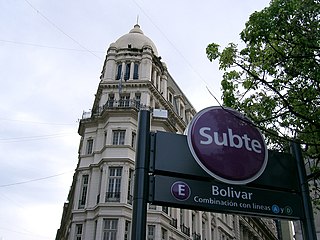
Line E of the Buenos Aires Underground, which runs from Retiro to Plaza de los Virreyes, currently extending a total distance of 12 km. Opened in 1944, the Line E was the last completely new line to be added to the Buenos Aires Underground, until 2007 when Line H was opened. The line has a history of being re-routed and extended due to having been historically the line with the lowest passenger numbers on the network.
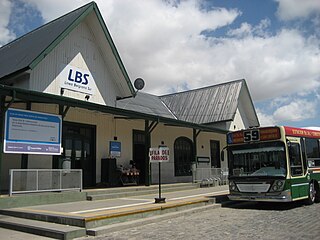
Buenos Aires is a former passenger railway station in the city of Buenos Aires, Argentina. The station was terminus of the Belgrano Sur line that runs trains along Greater Buenos Aires region.
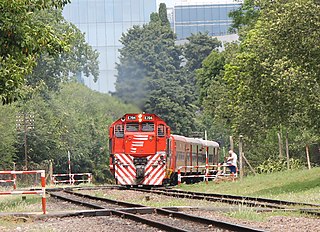
The Belgrano Norte line is a commuter rail service in Buenos Aires, Argentina run by the private company Ferrovías since 1 April 1994. This service had previously been run by the state-owned General Belgrano Railway since nationalisation of the railways in 1948. Ferrovías also formed part of the consortium UGOFE which operated other commuter rail services in Buenos Aires.
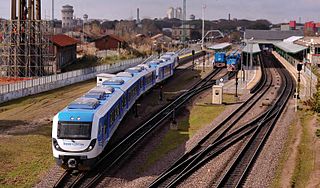
The Belgrano Sur line is an Argentine 1,000 mmmetre gauge commuter rail service in the Greater Buenos Aires area, currently operated by state-owned enterprise Trenes Argentinos. The Belgrano Sur runs over tracks and stations built by the Franco–Belgian-owned Compañía General de Buenos Aires and British Midland companies at the beginning of the 20th century.

Alberti is a station on Line A of the Buenos Aires Underground. The station belonged to the inaugural section of the Buenos Aires Underground opened on 1 December 1913, which linked the stations Plaza Miserere and Plaza de Mayo. Like the Pasco station, it is one of two stations of the line which only has one platform, in this case only serving passengers heading towards San Pedrito. The other platform is located just a few meters away, but was closed in 1953 since the proximity of Pasco station meant having so many stops in such quick succession slowed the line's frequency.

Pasco is a station on Line A of the Buenos Aires Underground. The station belonged to the inaugural section of the Buenos Aires Underground opened on 1 December 1913, which linked the stations Plaza Miserere and Plaza de Mayo. Like the Alberti station, it only has one platform, which in this case only serves passengers traveling to Plaza de Mayo. The other platform is located just a few meters away, but was closed in 1953 since the proximity of Alberti station meant having so many stops in such quick succession slowed the line's frequency.

Constitución is a station on Line C of the Buenos Aires Underground and is the current terminus. Here passengers can transfer to Metrobus Sur. The station is a part of the larger Constitución railway station which serves as the terminal for the General Roca Railway and Roca Line. The station was opened on 9 November 1934 as part of the inaugural section of the line, from Constitución to Diagonal Norte.

The Buenos Aires Metrobus is a 50.5 km (31.4 mi) network of dedicated separated lanes and stations for normal buses that serve the city of Buenos Aires, Argentina. Designed as a Bus Rapid Transit system, it mixes a few bi-articulated buses with conventional buses. The headway is the same as before the implementation of the system, and it lacks the brand of the network in the buses that use it, maintaining their previous branding as common bus lines with their own numbers. The service operates 24 hours a day and 365 days a year, with 2-4 minute frequencies during the day and 10–15 minutes at night.

Emepa Group S.A. is an Argentine manufacturer of railway vehicles and owner of Ferrovías, with headquarters located in the city of Buenos Aires. It had formerly owned Ferrocentral, which ran services from Buenos Aires to Córdoba and San Miguel de Tucumán on the Mitre Network, however the state-owned company SOFSE took over these services in 2014 and the subsidiary now remains inactive.
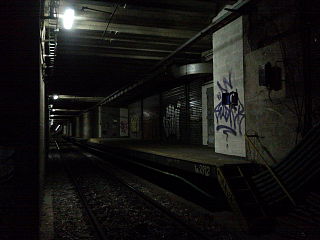
Alberti Norte is a ghost station in the Buenos Aires Underground, which was part of Line A until its closure in 1953. It is one of two ghost stations on the line, the other being Pasco Sur.

Constitución is a ghost station in the Buenos Aires Underground, which was part of Line E until its closure in 1966. It is one of two ghost stations on the line, the other being San José vieja. This was the original terminus of the line when it ended at Constitución railway station and combined with Line C there.

Facultad de Derecho-Julieta Lanteri Station is a station on Line H of the Buenos Aires Underground which opened on 17 May 2018 as a one-station extension from Las Heras. It currently serves as the northern terminus of the line until it is extended to Retiro. It is located next to the University of Buenos Aires Faculty of Law and the City's Exhibition and Conventions Centre and it is near the Recoleta Cemetery and Fine arts museum.
San José vieja is a ghost station in the Buenos Aires Underground, which was part of Line E until its closure in 1966. It is one of two ghost stations on the line, the other being Constitución.

Red de Expresos Regionales is a planned mass transit system in Buenos Aires which will connect the main rail terminals of the city through 16 km (9.9 mi) of tunnels with a central terminal. The tunnels will mean that the existing 815 km (506 mi) commuter rail network will be connected, with passengers being able to travel from one part of Greater Buenos Aires and La Plata to the other while only making one change at the new underground central terminal. The project is modelled on the Réseau Express Régional in Paris. It is estimated that after the completion of the project, combined with the current renewal of the commuter rail lines' rolling stock, passenger numbers will double from 1.4 million passengers per day to 3 million.

The CSR EMU is a series of electric multiple unit cars manufactured by CSR Corporation Limited for use on Buenos Aires' commuter rail network. The trains operate on three of the city's lines as of 2015 and 705 cars were manufactured, with each line using a different number of cars per train. They were created for use on lines electrified using both third rail and overhead lines.




















